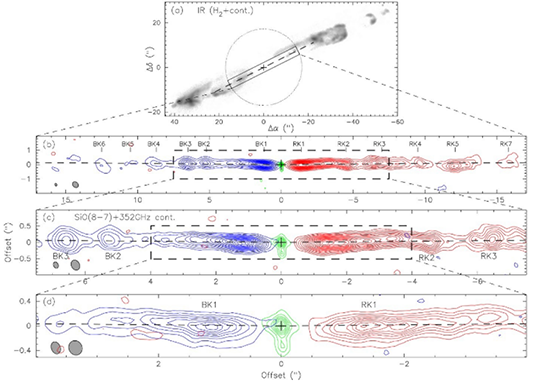Star Formation: Low-Mass:
Individual Low-mass Protostar Envelopes, Disks and Outflows
The angular resolution of the SMA is sufficient to separate Solar System scale disks from the dense gas envelopes surrounding embedded protostars, which has proved to be an important tool to study the physical processes at work in the complex systems of infall and outflow that accompany the youngest protostars. The SMA made the first resolved surveys of significant samples of embedded protostars at different stages of evolution. Important early results from the SMA on this topic included the unexpected realization that these disks are already substantial at an early phase (Jorgensen et al. 2007, 2009), the identification of both infall and rotational motions in the youngest systems (e.g. Lee et al. 2007), and detection of Keplerian rotation around embedded protostars, allowing their masses to be constrained for the first time (e.g. Brinch et al. 2007).
SMA observations of highly collimated molecular jets from very young protostars produced beautiful images (Figure 1) that place strong limits on any jet rotation, which tightly constrains the size of the jet-launching region, thereby testing directly the mechanisms proposed for outflow generation (e.g. Lee et al. 2009). The spatial filtering capabilities of interferometry enabled the SMA to make the first discoveries of low-mass, low-velocity molecular outflows from young brown dwarfs and candidate proto-brown dwarfs that are hidden in extended molecular clouds (Bourke et al. 2005; Phan-Bao et al. 2008). The angular resolution of the SMA has also enabled the identification of the driving source(s) of many larger scale outflows in regions containing multiple protostars (e.g. Chen et al. 2008).

SMA observatinos of the highly collimated jet from the protostar HH 211-mm: (a) the cross marks the position of the protostar at the center of bipolar shocked molecular hydrogen observed in the near-infrared; (b)-(d) 850 micron dust continuum contours are shown in green, and the jet emission as traced by SiO J = 8-7 emission is shown as red and blue contours for redshifted and blueshifted emission, respectively.
